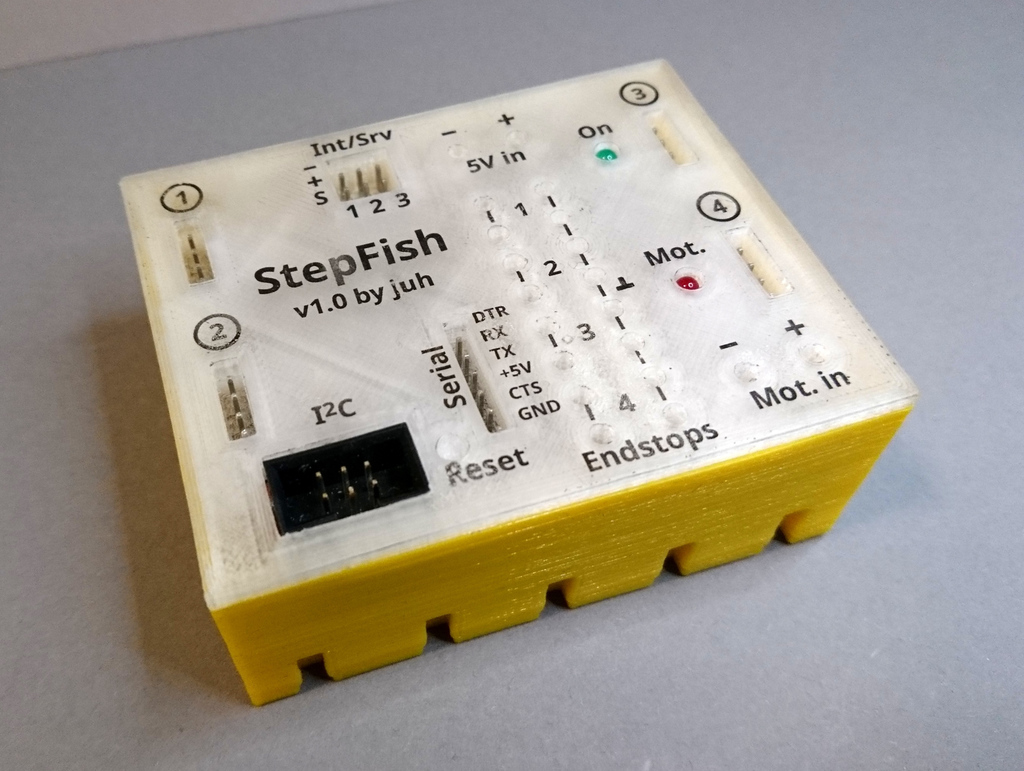
StepFish: fischertechnik I2C stepper motor controller
prusaprinters
<p>StepFish is a stepper motor controller for the <a href="https://www.fischertechnik.de/en">fischertechnik construction toy system</a> based on an ATmega328 microprocessor. It can be used as a standalone controller (and I2C master) or as an I2C slave. Hardware features:</p><p><strong>*up to four steppers</strong> driven by <a href="https://reprap.org/wiki/StepStick">StepStick</a>/<a href="https://www.pololu.com/product/1182">Pololu</a> or compatible carrier boards (e.g. A4988), connected via pin headers. Make sure to limit the carrier boards' current (see below).</p><ul><li>fischertechnik compatible connectors for<strong>two active low endstops</strong> per stepper axis <strong>*three PWM pins</strong> for custom uses like servos, LEDs, or interrupt pins in I2C slave mode <strong>*I2C connector</strong> compatible with the <a href="http://ftduino.de/">ftDuino</a> and fischertechnik TX controllers. <strong>*serial connector</strong> for programming or monitoring the ATmega328 with <a href="https://www.ebay.com/sch/i.html?_nkw=arduino+usb+serial+adapter">this kind of USB-serial/TTL/FTDI adapter</a></li><li>fischertechnik compatible connectors for<strong>5V in</strong> (chip logic) and<strong>stepper motor power</strong>. A DC-DC step-down 5V converter <a href="https://www.ebay.de/sch/i.html?_from=R40&_sacat=0&_nkw=3A+Mini+DC-DC+step+down+converter+volt+regulator+5V-23V+to+3.3V+6V+9V+12V&rt=nc&LH_PrefLoc=2">like this one</a> can be added to the enclosure internally if you want to power the controller from the motor pins only.</li><li>print-in-place<strong>reset button</strong></li><li>Two<strong>status LEDs</strong> for 5V (on) and stepper motor power. The ZIP-file contains fritzing, gerber and PDF files for producing the one-sided PCB, which uses my printed flush sleeve design ("<a href="https://www.thingiverse.com/thing:3375338">Printbuchse</a>") for the fischertechnik typical 2.6mm jacks. Soldering is a bit tricky, as the connector pins are placed at the bottom of the PCB. If you are interested in building one yourself, please message me, or leave a comment, and I will provide details.</li></ul><p><strong>Warning</strong>: Make sure to limit your carrier boards' current as described e.g. <a href="https://www.pololu.com/product/1182/faqs">here</a> or <a href="https://forum.arduino.cc/index.php?topic=415724.0">here</a> or <a href="https://lastminuteengineers.com/a4988-stepper-motor-driver-arduino-tutorial/#current-limiting">here</a>. My enclosure provides access to the carrier boards' potentiometers from the bottom, use an alligator clip attached to your screwdriver and one of the GND-pins for measurement.</p><p>You can use StepFish as a standalone controller, or control it remotely via I2C with my <a href="https://github.com/ftjuh/AccelStepperI2C">AccelStepperI2C firmware</a>.</p><p>Please consider leaving a "like" or posting your make as a token of appreciation for my work.</p><p>Find my other fischertechnik designs <a href="/juh/designs">here</a>.</p><p> </p><figure class="media"><oembed url="https://youtu.be/MyCck4btWzE"></oembed></figure><p> </p><p>keywords: fischertechnik I2C print-in-place Printbuchse printinplace Servo stepper_motor TWI</p><p>Category: Electronics</p>
With this file you will be able to print StepFish: fischertechnik I2C stepper motor controller with your 3D printer. Click on the button and save the file on your computer to work, edit or customize your design. You can also find more 3D designs for printers on StepFish: fischertechnik I2C stepper motor controller.
